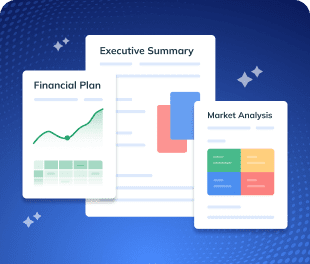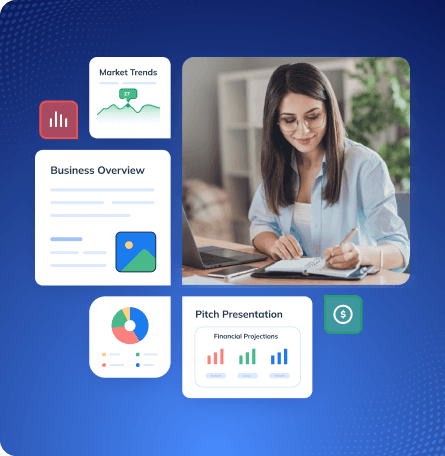Have you decided to launch your own tutoring business? Great choice!
Because tutoring is one of the most in-demand services, and it doesn’t take a fortune to get started.
But let’s be honest—winging it with no plan is a fast track to chaos. A simple business plan helps you get your ideas out of your head, figure out what actually works, and avoid scrambling later.
Not sure how to write a plan?
Don’t worry! This tutoring business plan template will walk you through why a business plan is essential and exactly how to write one step by step.
Let’s dive in!
Why do you need a business plan for tutoring services?
Whether you’re a solo tutor or planning to start a tutoring center, a business plan can be a game-changer. Here’s why a business plan is critical for your tutoring venture:
- Gives you clear direction
- Attracts investors and builds trust
- Defines your market and competitive advantage
- Helps you manage finances wisely
- Guides your decision-making and business growth
In short, a tutoring business plan isn’t just a document for show—it’s your strategic blueprint. It helps you clarify your ideas, prove the viability of your business to others, and manage your operations effectively.
How to create an effective tutoring business plan?
Writing a tutoring business plan involves covering several key sections that together paint a full picture of your business: What you do, how you do it, who you serve, and how you’ll succeed.
Here’s a step-by-step guide to creating a comprehensive tutoring business plan:
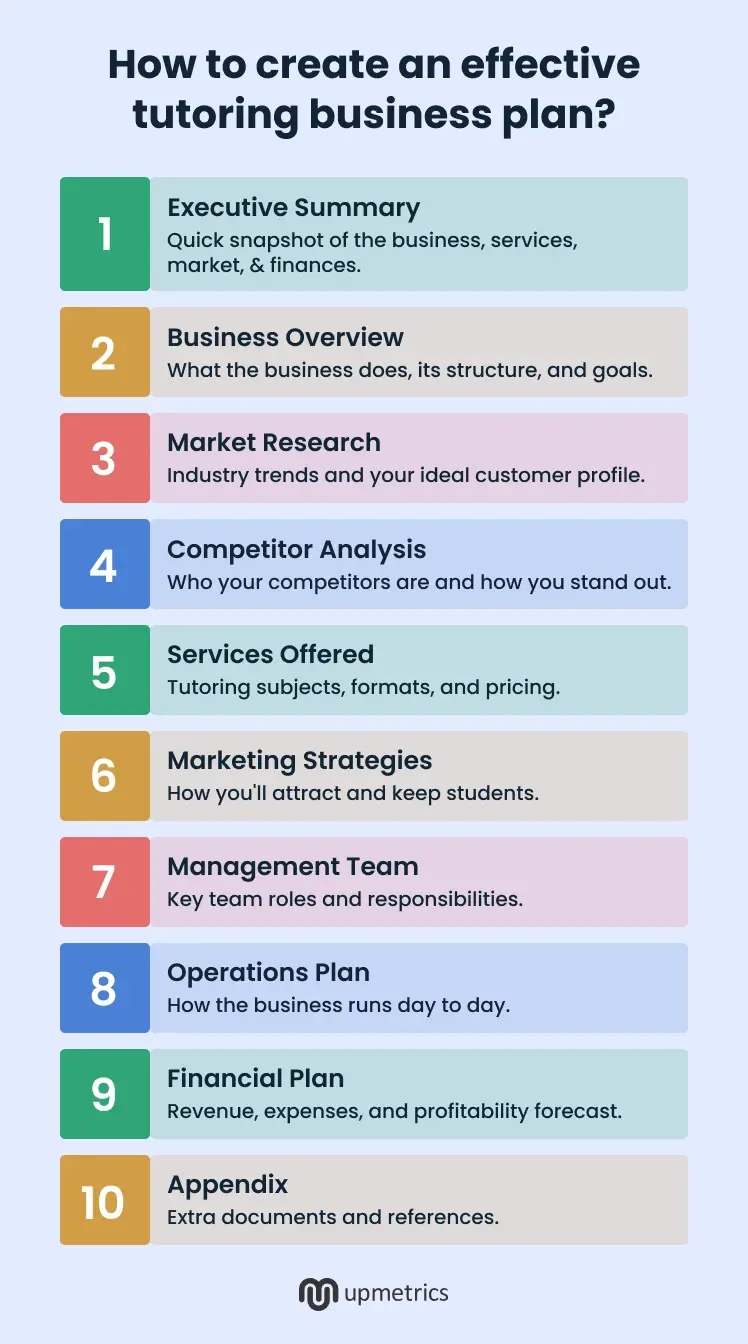
1. Executive Summary
The executive summary is the first section of your tutoring business plan, providing a high-level overview of your entire plan.
Basically, it serves as your business’s elevator pitch. So, keep it clear, concise, and compelling, because this is the first thing anyone reads (and busy investors may sometimes only read this part!).
If your executive summary is interesting, it will capture the reader’s attention and convince them to keep reading about your tutoring business.
In 1–2 pages, summarize the most important points of your plan. Include key facts like:
- What’s your business concept? And where are you located?
- Who are your target customers?
- What need are you fulfilling?
- What does your tutoring business offer? What sets you apart?
- What are your financial goals and expected revenue?
Even though the executive summary appears at the front, you’ll find it easier to write this section after you’ve drafted all the details in the rest of your plan.
That way, you can pull the most important points from each section into a compelling summary that does justice to your business.
Say goodbye to boring templates
Build your business plan faster and easier with AI
Plans starting from $14/month

2. Business Overview
Now it’s time to describe your tutoring business in detail. This section provides foundational information about your company, including its structure, location, history (if any), and what you aim to accomplish.
Here’s how to approach your company overview section:
Begin with the name of your business, where you’re located, and whether you offer tutoring online, at home, or in a physical center.
Then, mention the type of business legal structure you have, like sole proprietorship, partnership, or LLC. If you picked a certain setup for a reason, such as lower taxes or legal protection, you can briefly mention that too.
State your mission and vision statement. It’s also good to include what you aspire to achieve in the long run.
If your tutoring business is brand new, you might not have much history to share, and that’s fine. Just state it’s a startup. But if you’ve been tutoring informally for years or have an interesting origin story, include a brief background.
Any achievements so far (like “helped 50 students improve their grades over two years”) can be noted here to show traction. Lastly, don’t forget to summarize your short-term and long-term goals.
Essentially, this section gives a snapshot of your business identity and strategy. Make sure to convey your passion and the strengths of your business idea. This helps build confidence in your venture right from the start.
3. Market Research
The market research section shows that you’ve done your homework about the tutoring industry and the specific market you plan to serve.
This is where you demonstrate your understanding of the demand, the customers, and the overall environment in which your tutoring business will operate.
When conducting your market research, cover these key points:
Industry Overview
Start broad. What is the current state of the tutoring or education services industry? Note if the industry is growing and why. If you have stats, include them. For instance:
“The private tutoring market is expected to reach $157.0 billion by 2034 from $64.4 billion in 2024, growing at nearly 9% annually. This indicates strong and rising demand for supplemental education.”
Market Needs
Explain the gap or need in the market that you intend to fill. Perhaps local schools are overcrowded and students don’t get enough individual attention, or there’s no specialized SAT tutor in your town.
Maybe existing tutoring centers are expensive, and you can offer a more affordable or flexible solution. Make a case for why there’s room for your business.
Target Market
Describe your specific target market in detail. Who exactly are your ideal customers?
Are you targeting elementary school kids, high school students, college students, or maybe adult learners (like professionals learning a new language)?
Define their demographics (age, education level) and their needs like this:
| Target Segment | Age Range | Education Level | Primary Needs / Goals |
|---|---|---|---|
| Elementary School Kids | 6–11 years | Grades 1–5 | Basic literacy and numeracy skills, homework help, foundational learning |
| High School Students | 14–18 years | Grades 9–12 | Subject-specific tutoring, test prep (SAT/ACT), college readiness |
| College Students | 18–24 years | Undergraduate level | Advanced academic support, coursework assistance, skills for job readiness |
| Adult Learners | 25+ years | Professionals/Graduates | Learning new skills (e.g., languages, coding), career advancement, upskilling |
Recent Trends
Discuss any relevant trends in tutoring. Are more services moving online? Is there a seasonal peak (for example, a rush before exams or college entrance tests)?
Mention things like the effect of COVID-19 (which greatly accelerated acceptance of online tutoring), the use of educational technology or apps, or increasing emphasis on certain tests or curricula.
By thoroughly researching your market, you’ll not only impress readers of your plan but also equip yourself with vital knowledge. You might discover insights that can shape your strategy.
4. Competitor Analysis
No business plan is complete without looking at the competition!
In the competitor analysis section, you’ll identify who you’re up against in the tutoring space and how you plan to differentiate your services.
Here’s how to conduct a competitor analysis for a tutoring business:
Step 1: Identify your competitors and list out other tutoring providers that target the same students or subject areas you intend to. Competitors can be:
- Other private tutors or local tutoring centers in your area
- Websites or platforms that offer tutoring or test prep virtually, like Chegg, Tutor.com
- Nonprofits or after-school programs offer tutoring to students for free or low cost
Step 2: For each major competitor, note what services they offer and at what price point. Create a simple comparison.
Step 3: Analyze their strengths and weaknesses: What do competitors do well? And where do they fall short? Read reviews if available, or talk to students/parents to gather insights.
Step 4: Find where you have a competitive edge and clearly state how your tutoring business will stand out.
By performing a competitor analysis, you’re not looking to knock anyone down. Rather, you’re identifying opportunities for your business to shine.
Furthermore, you can include a SWOT analysis (Strengths, Weaknesses, Opportunities, Threats) in this section. It helps you assess internal strengths/weaknesses of your business and external opportunities/threats in the market.
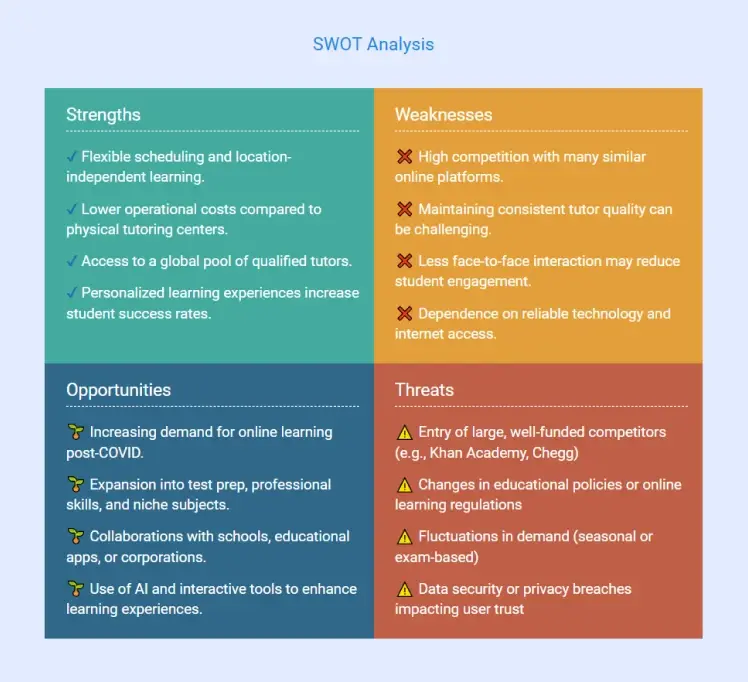
Overall, this section gives confidence that you understand the competitive dynamics and have a plan to compete effectively.
5. Services Offered
This section of your business plan details what services you’ll offer as a tutor. It might seem obvious, but it’s important to be specific and clear about the scope of your services, the formats, and any unique features of how you deliver tutoring.
Outline your services like so:
- Subjects and areas of specialization
- Grade levels or age range
- One-on-one tutoring (either in-person or online)
- Group sessions or classes
- Session structure and curriculum/materials used
If applicable, mention any additional services, like homework help sessions, college counseling, study skill workshops, or even tutoring package deals. List them if relevant.
You might also highlight if you offer a free trial session or consultation—a great selling point to get clients in the door.
Finally, highlight any unique aspect of your service offering. Do you have a mobile app for scheduling or reviewing materials? Do you offer 24/7 Q&A support via chat for your students?
6. Marketing Strategies
Your marketing strategy section will outline how you plan to promote your tutoring business and attract clients. This is especially important for a tutoring startup to actively reach out to find students and parents who need tutoring services.
“Build it and they will come” doesn’t quite work in business. Your strategy needs to be smart and targeted because you likely won’t have a big marketing budget.
While planning this section, consider including your unique value proposition, promotional channels, partnerships, pricing strategy, as well as marketing goals.
Here are some effective marketing tactics for tutoring businesses to get the word out:
- Online marketing through a website and social media
- Local advertising (flyers, business cards, and brochures)
- Word-of-mouth & referrals programs
- Online tutor platforms like Wyzant, Tutors.com, or even Thumbtack
- Targeted Facebook or Google ads
- Collaborations with local schools, after-school programs, or youth centers
If you have a business name and logo, mention how you’ll use branding consistently. Even a catchy tagline like “Building Better Learners” for your tutoring can make your marketing materials more memorable.
In short, this section of your tutoring business plan proves that you know how to get clients, which is critical for convincing anyone that your business will succeed.
7. Management Team
Who is running the show, and what makes them capable? The management team section highlights the people behind the business.
In a tutoring business, this often is just you (the owner) and perhaps a few tutors or staff. Whether it’s a one-person operation or a growing team, use this section to instill confidence that the business is in good hands.
Start by introducing the owner(s) of the business. If that’s you, provide a brief bio focusing on your credentials and experience that relate to tutoring and business management.
If you have other key team members, introduce them. This could be additional tutors, a co-founder, an administrative assistant, a marketing partner, etc. For each, give a short description of their roles and responsibilities, background, and expertise they bring to the table.
Further, you can add an organizational chart that helps explain the structure of your business in terms of hierarchy or roles. In a small business, this is simple: e.g.,
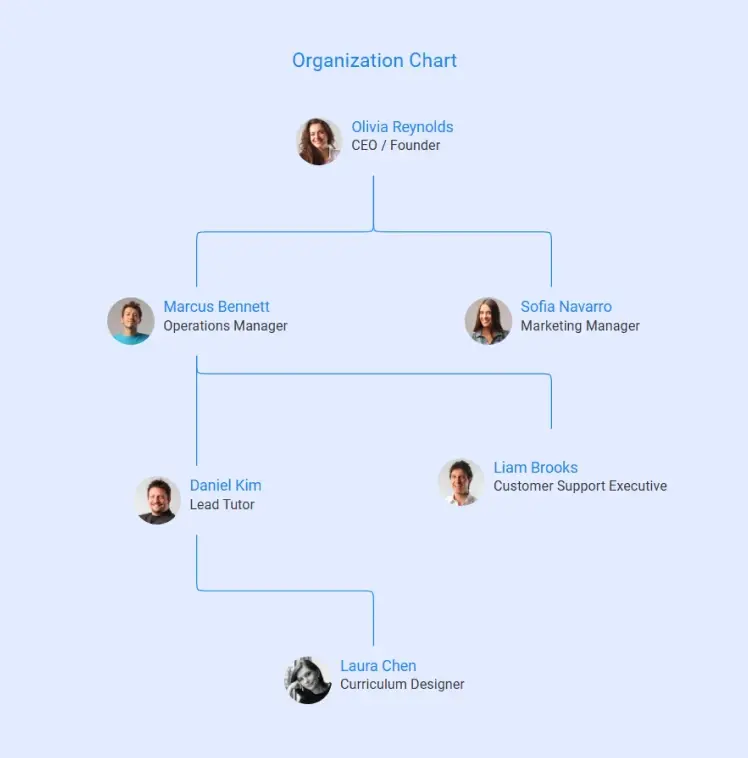
If you have any advisors, such as a retired principal advising you, a business mentor, or even an accountant or lawyer whom you rely on for guidance, you can mention them briefly.
This can add credibility; it shows you have a support network and are seeking guidance.
8. Operations Plan
The operations plan section explains the day-to-day running of your tutoring business. In other words, how will you deliver your services efficiently and effectively?
While earlier sections talked about what you’re doing, this part covers how you’ll do it. It’s all about the logistics, processes, and systems that will keep your business running smoothly behind the scenes.
Here are elements to include in your operations plan:
- Tutoring service delivery process
- Location and facility
- Scheduling and capacity
- Hiring plan and training
- Equipment or tools used
- Legal and safety considerations
In addition to these operational aspects, outline how you’ll handle customer service, including communication and support. This kind of detail shows you’re thinking about the client’s experience thoroughly.
Simply put, this section reassures the reader that you know how to execute your plan on a practical level. It means fewer surprises and a more professional service, which ultimately leads to happy clients and a sustainable business.
9. Financial Plan
The financial plan is where you provide the financial projections for the next few (3-5) years and demonstrate the viability of your tutoring business in monetary terms.
This section is incredibly important if you’re seeking a loan or investment, but even if you’re not, it’s vital for you to understand the financial roadmap of your business.
A tutoring business might have relatively low expenses, but you still need to plan for how you’ll make money, how you’ll manage costs, and when you’ll break even.
Your tutoring financial plan should typically include startup costs, revenue streams, operating expenses, as well as profitability and return on investment (ROI). Plus, enclose these key financial statements and documents in your plan:
- Income statement
- Cash flow statement
- Balance sheet
- Break-even analysis
For reference, you can check out an example of projected financial statements below to calculate your own.
Income Statement
| Category | Amount (USD) |
|---|---|
| Revenue | |
| Tutoring Session Fees | $300,000 |
| Subscription Packages | $60,000 |
| Course Material Sales | $18,000 |
| Total Revenue | $378,000 |
| Cost of Goods Sold (COGS) | |
| Tutor Payments | $144,000 |
| Platform & Content Licensing | $20,400 |
| Total COGS | $164,400 |
| Gross Profit | $213,600 |
| Operating Expenses | |
| Salaries (Admin, Marketing) | $60,000 |
| Marketing & Advertising | $24,000 |
| Website & Hosting | $3,600 |
| Software Subscriptions | $4,800 |
| Miscellaneous Expenses | $3,600 |
| Total Operating Expenses | $96,000 |
| Net Operating Profit (EBIT) | $117,600 |
| Income Tax (20%) | $23,160 |
| Net Profit After Tax | $92,640 |
Cash Flow Statement
| Category | Amount (USD) |
|---|---|
| Cash from Operating Activities | |
| Net Profit (After Tax) | $92,640 |
| Adjustments & Working Capital Changes | ($1,800) |
| Net Operating Cash Flow | $90,840 |
| Cash from Investing Activities | |
| Equipment & Platform Development | ($9,000) |
| Net Investing Cash Flow | ($9,000) |
| Cash from Financing Activities | |
| Owner’s Capital – Loan Repayment | $6,000 |
| Net Financing Cash Flow | $6,000 |
| Net Increase in Cash | $87,840 |
| Opening Cash Balance | $5,000 |
| Closing Cash Balance | $92,840 |
Balance Sheet
Assets
| Category | Amount (USD) |
|---|---|
| Current Assets | |
| Cash | $92,840 |
| Accounts Receivable | $5,000 |
| Total Current Assets | $97,840 |
| Non-Current Assets | |
| Equipment & Website (Net) | $13,400 |
| Total Non-Current Assets | $13,400 |
| Total Assets | $111,240 |
Liabilities
| Category | Amount (USD) |
|---|---|
| Accounts Payable | $4,000 |
| Taxes Payable | $3,160 |
| Loan Payable | $6,000 |
| Total Liabilities | $13,160 |
Owner’s Equity
| Category | Amount (USD) |
|---|---|
| Capital Invested | $10,000 |
| Retained Earnings | $88,080 |
| Total Owner’s Equity | $98,080 |
Break-Even Analysis
| Item | Amount (USD) |
|---|---|
| Total Revenue (Projected) | $378,000 |
| Total Variable Costs (COGS) | $164,400 |
| Contribution Margin | $213,600 |
| Contribution Margin Ratio | 56.5% |
| Fixed Costs (Operating Expenses) | $96,000 |
| Break-Even Revenue | $170,000 |
If you’re seeking funding (loan or investment), clearly state how much you need and what it’s for. Even mention any personal investment you’re making.
In addition, list your key assumptions, as these underpin your projections. Also, inflation or cost increases, if any (maybe you assume you’ll raise tutor rates by 5% in year 3, etc.). Being transparent about assumptions helps readers trust your numbers.
Remember, accuracy and realism are key to this section. Don’t wildly overestimate. It’s better to be slightly conservative and then outperform your plan than the opposite.
10. Appendix
The appendix is the optional last section of your tutoring business plan. Not every plan has one, but it’s a place for any additional documents or information that would clutter the main sections.
Think of it as a reference section for readers who may want more detail on certain points. In the business plan appendix, you might include:
- Resumes or CVs of you and any key team members
- Certificates and credentials
- Sample marketing materials
- Letters of reference or testimonials
- Contracts or legal documents
- Detailed market data
Always remember to label the appendix items and reference them in the plan when appropriate. This way, a reader knows exactly where to look if they want the nitty-gritty of something.
Download a free tutoring business plan template
Ready to start writing a plan? But feeling a bit overwhelmed by all the details you need to include? Worry not; you don’t have to start from a blank page. Here’s a free tutoring business plan template to help you get started.
This template is fully customizable and designed specifically for tutoring businesses. It includes all the sections we discussed, along with prompts and examples. So, you just have to fill in your information and get an investor-ready plan ready in minutes.
The Quickest Way to turn a Business Idea into a Business Plan
Fill-in-the-blanks and automatic financials make it easy.
Summary
Summing up! We’ve discussed all the essential elements of a comprehensive tutoring business plan, starting from business concept and target students to competition and financial forecasts.
Now, it should be much easier for you to draft your own business plan for tutoring services.
However, if you’re still feeling stuck or looking for a quick way to plan things right, Upmetrics can be your go-to tool. It comes with advanced AI capabilities, financial planning features, sample plans, and hundreds of business resources to make your planning process easier.
So, wait no longer; give it a try!
